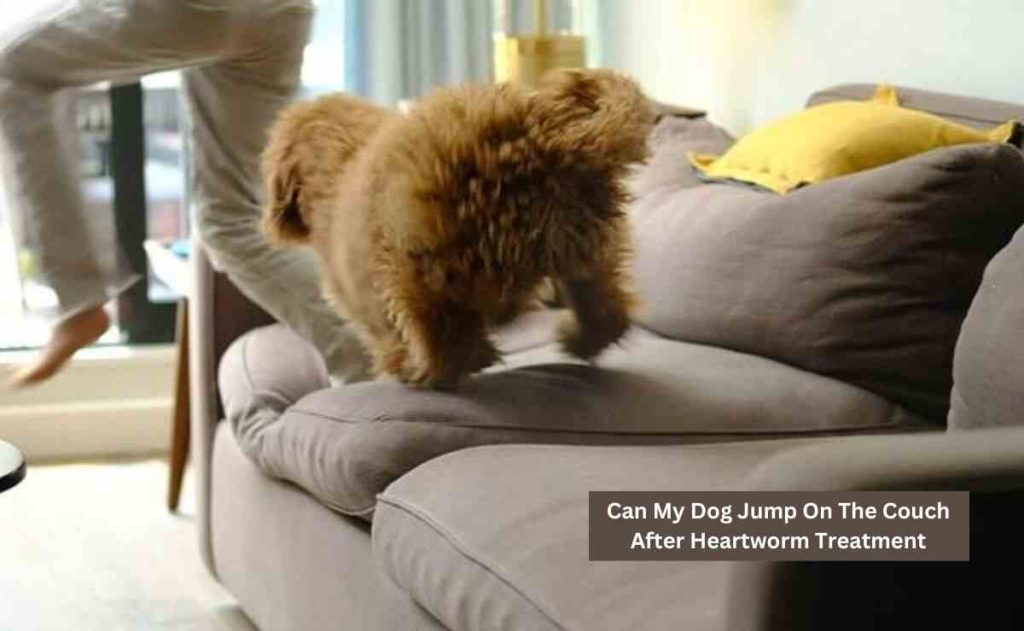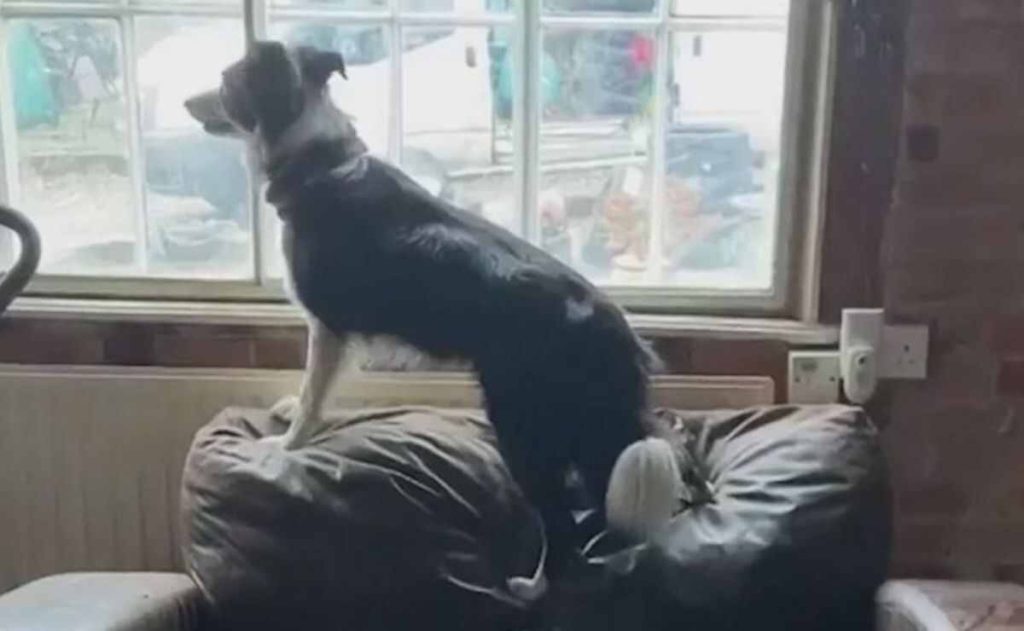Heartworm is a deadly disease for dogs and cats. It is a treatable health problem. Still, many pet owners wonder can my dog jump on the couch after heartworm treatment?
After heartworm treatment, it is essential to ensure home care. This is crucial throughout the entire post-treatment period. During this time, the worms slowly die and are destroyed by the body’s natural processes. You need to restrict the dog’s excessive movement.
So your dog should not jump on the couch after heartworm treatment. While it might seem like a harmless activity, jumping is a level of physical exertion that is best avoided during the post-treatment phase. The stress on the heart and lungs during these actions can hinder the healing process and put your dog at risk.
What Is Heartworm?
Heartworm disease is a serious disease. Dirofilaria immitis is responsible for this fatal disorder. It’s a worm that takes residence in the circulation, primarily in the heart and lungs. The infection is transmitted through mosquitoes from one animal to another.
The key to treating heartworm disease is melarsomine which is a prescription veterinary drug. It is a series of injections, this medication is specifically designed to eliminate heartworms in dogs. However, the treatment is not safe for cats.
One of the critical aspects of heartworm treatment is the gradual elimination of the worms. Rapid killing of heartworms can pose significant risks, including the obstruction of blood flow, which could be life-threatening. Therefore, gradual treatment is crucial for the safety of your dog.
Can My Dog Jump On The Couch After Heartworm Treatment?

Injectable heartworm adulticide treatment effectively prevents the disease. However, the post-treatment period requires special attention.
During heartworm treatment, the decomposing bodies of the dead worms can pose a risk. It can cause blockages in blood vessels and fatal blood clots, especially in the lungs. Maintaining a calm environment is essential for your dog.
Heartworms affect the most major organs. It should be prevented through a prolonged treatment plan and medication. The infection usually continues for 8 weeks and during this time, your dogs should stay inactive and in a calm environment. If their movement is excessive, it will increase heart rate and blood pressure, which could pose the risk of complications.
Moreover, heartworms can indirectly transmit from dogs to humans through fecal matter. Hence, quarantining your dog during the treatment period is essential to prevent any potential transmission and ensure the safety of both your pet and your family.
How Long Does A Dog Need To Be Crated After Heartworm Treatment?
According to the guidelines set by the American Heartworm Society, your dog will need approximately 5 months of rest after being diagnosed with Injectable heartworm adulticide treatment before they can return to their previous levels of physical activity. This extended period is necessary for the completion of various heartworm prevention medications and treatments (melarsomine injections).
Even after the 5-month mark, it’s crucial not to expect your dog to immediately revert to their earlier routine. Because their body potentially decreases in their tolerance for physical exertion during the treatment and recovery phases.
You may seem, it’s a lengthy resting period. But it’s a small sacrifice to ensure your dog’s health and happiness in the long run. Their body undergoes a significant process during treatment, and pushing them back into a high-energy routine too soon could lead to life-threatening complications.
What Happens if My Dog Jump On The Couch After Heartworm Treatment?
If your dog gets too excited after heartworm treatment, it can make their heart beat faster. This increased heart rate might cause bits of the decomposing heartworm to move around and block the bloodstream.
Usually, this affects the lungs and can lead to breathing problems and other serious complications. It could be fatal for your dog. If you notice signs like difficulty breathing, it’s crucial to contact your vet right away.
That’s why it’s important to give your dog 6 to 8 weeks of rest even after finishing the heartworm treatment. While the medication works to eliminate the heartworms, the small leftover pieces of the worms take about 6 weeks to break down and completely leave your dog’s system.
During this time, it’s essential to keep your dog quiet and calm to avoid any complications during the decomposing process.
Can my dog go up and down stairs after heartworm treatment?
After heartworm treatment, it’s advisable to restrict your dog’s activity, and this includes going up and down stairs. The period of heartworm treatment is critical for your dog’s recovery. Allowing them to climb stairs potentially puts a strain on their cardiovascular system.
Stair climbing requires additional effort and can increase the heart rate, which can pose risks during the post-treatment phase. It’s recommended to follow your veterinarian’s guidance, but generally, keeping your dog’s activity level low and avoiding strenuous activities like stair climbing is necessary.
During the recovery period, make sure a calm and controlled environment for your dog. Restrict access to stairs. This reduces the risk of any adverse reactions related to the heartworm treatment.
How to Keep a Dog Comfortable After Heartworm Treatment?

After your dog undergoes heartworm treatment, it’s crucial to prioritize a calm and restful recovery period. So here are some tips to keep your dog still and comfortable during this time.
- Keep in a Quiet Room
To maintain a calm environment, keep your dog in a quiet room. If you have multiple dogs, try to limit the company to avoid overwhelming your recovering pet. To avoid exposing your dog to strangers, get a friend to watch over them if necessary.
- Place A Leash for Controlled Movement
If your dog tends to be energetic or has a history of being very active, ensure they are on a leash during the recovery period. It prevents them from running around, potentially injuring themselves, and reduces the risk of post-treatment complications.
- Tethering
Tethering is another effective method to control and comfort your dog during recovery days. When your dog seems restless, provide comfort and give them a gentle massage. This special time together not only helps them get better but also strengthens the bond between you and your furry friend.
- Use a Crate
Using a crate serves multiple purposes. It restricts movement, prevents excessive activity, and safeguards against jumping when you open the front door. You can provide them with toys, a large bone for chewing, and a puzzle toy to keep them engaged so they won’t feel bored.
Frequently Asked Questions (FAQs)
Does a Dog Need Crate Rest for Heartworm Treatment?
Yes, crate rest is often recommended after heartworm treatment. It provides a controlled environment and reduces the risk of complications during the post-treatment phase.
Can You Walk Your Dog Outside After Heartworm Treatment?
During the initial recovery period, it’s generally recommended to limit outdoor activities. Your dog can walk outside but put on a leash to control their movement.
Conclusion
Heartworm disease is a serious threat to your dog’s health. So keep them at rest until they recover completely. So, unfortunately, your dog can’t jump on the couch during the recovery period.
You must wait at least 5 months before they back to their regular activities. Also, always consider vet’s recommendations for their safety.
